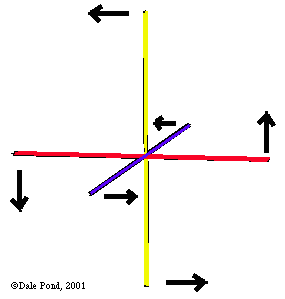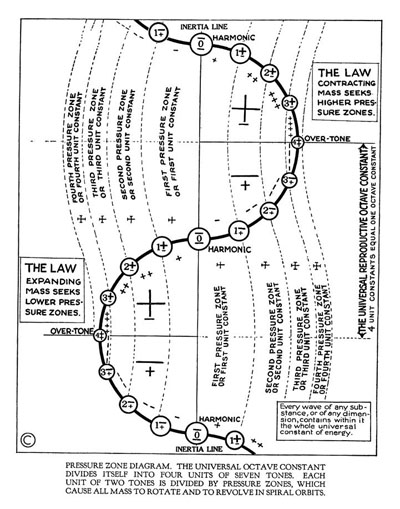"All corpuscular action in Nature is vortex motion." [Keely, VORTEX ACTION]
3.03 - Vortexial Motion - As an expanding wave front of an entropic wave reaches the Plane of Inertia it reverses polarity and begins to collapse back (syntropy) to the center due to mutual assimilation between all participating particles/centers. Concurrently the wave, as it moves outward towards the Plane of Inertia, loses energy, loses polarity and loses form in direct proportion to its distance from the center and approximates the Plane of Inertia. See Square Law The participating particles assimilate going in syntropically but mutually disperse going out entropically. The collapsing syntropic wave encounters and conflicts with more entropic wave fronts. This confliction of mixtures of varying polarizations results in the inward and outward vectors skewing or slipping around each other thus initiating vortexial motions. The skewing around each other occurs by virtue of the LEVELS or DEGREES of Polarization as may be seen in Russell's Focalizing Lenses graphics and represented in his Scale of Locked Potentials. It is further seen that once polarization is initiated vortex or gyroscopic motion is natural and seemingly spontaneous.
"The order of vibration associated with the transmission of odor acts by sympathetic negative interference; and, consequently, moves in circles, with a velocity of 220,000 per second, at least." Keely and His Discoveries
Some fascinating videos of vortices in action, collisions, etc.
http://serve.me.nus.edu.sg/limtt/

See Also
Bidirectional Wave Pair
Lens
Mate-Pairs
pressure lense
retroactive
Wave Pair

Keely
"Pure sympathetic concordants are as antagonistic to negative discordants as the negative is to the positive, but the vast volume the sympathetic holds over the non-sympathetic, in ethereal space, makes it at once the ruling medium and readjuster of all opposing conditions if properly brought to bear upon them." [Snell Manuscript - The Book, page 3]
See Also

See Also
9.23 - Circular Harmonic Orbit
9.24 - Elliptical Enharmonic Orbit
9.26 - Orbital Phases
12.38 - Orbital revolution
Cyclotronic Motion
Depolar
differential densities
Differentiation
Figure 2.10 - Triple Dual Vectors - In Rotary Motion
Figure 3.4 - Focalizing Lenses at nested Cube faces
Figure 3.5 - Conflicting and Opposing Vector Potentials
Figure 3.6 - Tornado Vacuums up Everything for Redistribution
Figure 3.6.1 - Tornadoes also have a Down Draft caused by its vacuous center
Figure 9.11 - Compression Wave with expanded and contracted Orbits
Figure 13.21 - Differential Pressure Zones in Antagonism cause Rotation
Gyrokinetics
Orbital Plane
Polar
spin-orbit coupling
translatory motion
Vortex
VORTEX ACTION
